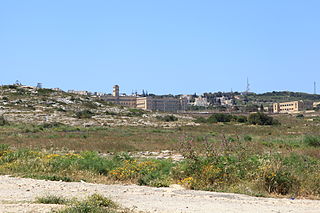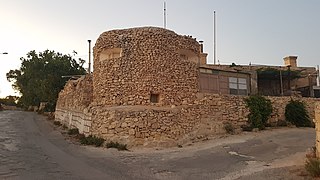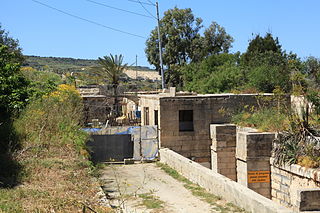
Pembroke is a town in the Northern Region of Malta, and it is considered to be the country's newest locality. To the east is Paceville, the nightlife district of Malta. The coastal town and tourist hub of St. Julian's lies to the southeast, and the residential area of Swieqi lies to the south. The hilltop village of Madliena is to its west, and Baħar iċ-Ċagħaq lies to the northwest.

Fort Ricasoli is a bastioned fort in Kalkara, Malta, which was built by the Order of Saint John between 1670 and 1698. The fort occupies a promontory known as Gallows' Point and the north shore of Rinella Bay, commanding the entrance to the Grand Harbour along with Fort Saint Elmo. It is the largest fort in Malta and has been on the tentative list of UNESCO World Heritage Sites since 1998, as part of the Knights' Fortifications around the Harbours of Malta.

A redoubt is a fort or fort system usually consisting of an enclosed defensive emplacement outside a larger fort, usually relying on earthworks, although some are constructed of stone or brick. It is meant to protect soldiers outside the main defensive line and can be a permanent structure or a hastily constructed temporary fortification. The word means "a place of retreat". Redoubts were a component of the military strategies of most European empires during the colonial era, especially in the outer works of Vauban-style fortresses made popular during the 17th century, although the concept of redoubts has existed since medieval times. A redoubt differs from a redan in that the redan is open in the rear, whereas the redoubt was considered an enclosed work.

Fort Manoel is a star fort on Manoel Island in Gżira, Malta. It was built in the 18th century by the Order of Saint John, during the reign of Grand Master António Manoel de Vilhena, after whom it is named. Fort Manoel is located to the north west of Valletta, and commands Marsamxett Harbour and the anchorage of Sliema Creek. The fort is an example of Baroque architecture, and was designed with both functionality and aesthetics in mind.

Fort St. Angelo is a bastioned fort in Birgu, Malta, located at the centre of the Grand Harbour. It was originally built in the medieval period as a castle called the Castrum Maris. It was rebuilt by the Order of Saint John as a bastioned fort called Fort Saint Angelo between the 1530s and the 1560s, and it is best known for its role as the Order's headquarters during the Great Siege of Malta of 1565. A major reconstruction to designs of Carlos de Grunenbergh took place in the 1690s, giving the fort its current appearance.

Madliena Tower, originally known as Torre della Paulina, is a small watchtower in Madliena, limits of Pembroke, Malta. It was completed in 1658 as the fourth of the De Redin towers. The British built an artillery battery next to the tower in 1908–1909, and the tower and battery remained in use until World War II. Today, the battery no longer exists but the tower is in good condition.

Saint Paul's Battery, also known as Ta' Lombardi Battery, is an artillery battery in Marsaxlokk, Malta. It stands on high ground at the shoreward end of Delimara Point, above il-Ħofra-z-Zgħira. It is a polygonal fort and was built by the British from 1881 to 1886. It commands a field of fire northwards over St Thomas' Bay and Marsaskala.

The Victoria Lines, originally known as the North West Front, are a line of fortifications that spans 12 kilometres along the width of Malta, dividing the north of the island from the more heavily populated south.

Fort Ballance is a former coastal artillery battery on Point Gordon on Wellington's Miramar Peninsula.

Fort Tigné is a polygonal fort in Tigné Point, Sliema, Malta. It was built by the Order of Saint John between 1793 and 1795 to protect the entrance to Marsamxett Harbour. It is one of the oldest polygonal forts in the world. The fort, extensively altered by the British in the 19th century, remained in use by the military until 1979.

The fortifications of Malta consist of a number of walled cities, citadels, forts, towers, batteries, redoubts, entrenchments and pillboxes. The fortifications were built over hundreds of years, from around 1450 BC to the mid-20th century, and they are a result of the Maltese islands' strategic position and natural harbours, which have made them very desirable for various powers.

Garden Battery is an artillery battery in Sliema, Malta. It was built by the British between 1889 and 1894. The battery is located at Tigné Point, between Cambridge Battery and Fort Tigné.

Cambridge Battery is a Victorian-era battery in Sliema, Malta. It is commonly referred to as Fort Cambridge, although it was never classified as a fort while in use. It originally contained an Armstrong 100-ton gun.

Fort Pembroke is a polygonal fort in Pembroke, Malta. It was built between 1875 and 1878 by the British to defend part of the Victoria Lines. The fort now houses the Verdala International School.

Fort Campbell, also known locally as Il-Fortizza ta' Selmun, is a former fort in Mellieħa, Malta. It was built by the British during 1937 and 1938. It is notable as the most important fortification north of the Victoria Lines, and the last major fortification to be built in Malta. Today, it lies in ruins.

The fortifications of Valletta are a series of defensive walls and other fortifications which surround Valletta, the capital city of Malta. The first fortification to be built was Fort Saint Elmo in 1552, but the fortifications of the city proper began to be built in 1566 when it was founded by Grand Master Jean de Valette. Modifications were made throughout the following centuries, with the last major addition being Fort Lascaris which was completed in 1856. Most of the fortifications remain largely intact today.

Wolseley Battery is an artillery battery in Delimara, Marsaxlokk, Malta. It was built by the British between 1897 and 1899, and is located close to Fort Tas-Silġ. Today, the battery still exists, but it is not accessible to the public.
Spinola Battery, also known as Fort Spinola, was an artillery battery in St. Julian's, Malta. It was built by the British between 1889 and 1894, and it was demolished to make way for hotels and a yacht marina.

Tarġa Battery is an artillery battery on the boundary between St. Paul's Bay and Mosta, Malta. It was built in 1887 by the British as part of the Victoria Lines. The battery is now in the hands of the Mosta Local Council, who intend to restore it and open it to the public.

Wardija Battery was an artillery battery in Wardija, a hilltop in the limits of St. Paul's Bay, on the northern coast of Malta. It was built by the British in 1915, and saw use during World War I. It became obsolete following the construction of Fort Campbell in 1938.



















